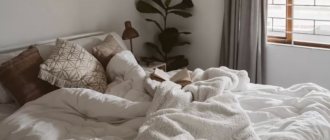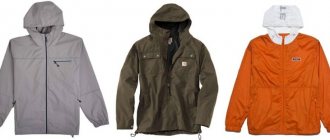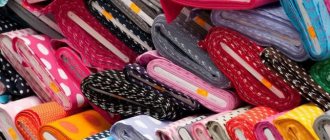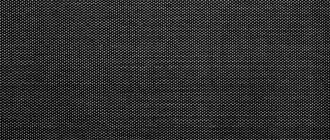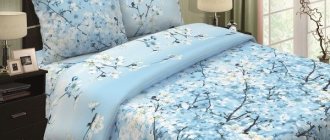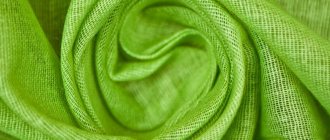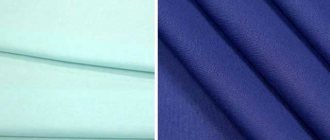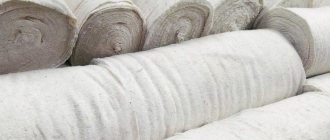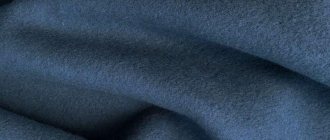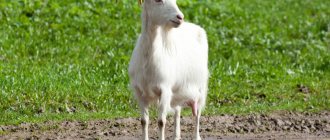Despite the fact that a lot of synthetic fabrics have appeared, the love for natural materials remains firmly in place. This can be judged by the natural bed linen in every home. The most popular is made from calico.
Calico has been known in Rus' for a long time. It was brought to the Moscow state by merchants from Asia back in the 16th century. The name of the fabric comes from the Arabic “bäzz”. At the end of the 18th century it began to be produced in Kineshma district. Linings for caftans and soldiers' underwear were made from affordable fabric. In the 19th century, children's and women's clothing was made from printed calico, and coat linings were made from plain-dyed calico.
What is calico
Calico is a cotton fabric with a cross-shaped weave of threads. Thanks to this weaving, the threads are located very close to each other, and the fabric is very dense. The material looks the same on both sides, the surface is smooth and matte.
Calico varies in density. The thickest fabric is 142 gsm. m is GOST calico, per 1 sq.cm of which there are at least 80 threads. Composition: 100% cotton threads. High-quality bed linen, curtains and even furniture upholstery are made from such dense material.
The second densest cotton fabric with a density of 125 g/sq.m., and the thinnest with a density of 100 to 65 g/sq.m. m. Summer clothes in the form of shorts and sundresses are sewn from such fabrics, and light tulle can be sewn from thin translucent fabric.
The photo clearly shows the texture of the fabric and the weave of the threads.
Comparison with other materials
There are many cotton materials, each with advantages and disadvantages. Calico can be compared to the following fabrics:
- poplin;
- satin;
- percale;
- chintz;
- moleskin.
Poplin is a cotton material. It is denser, more durable, but also soft. For a baby crib, it is better to take calico or poplin. These fabrics will not irritate children's skin; they absorb moisture well.
Satin is a cotton material with a satin weave. The fabric is dense, with a shiny surface. Comfortable to the body, but tough. Elite bed linen is made from satin.
For affordable and high-quality sets, it is better to buy percale or calico. These materials have approximately the same characteristics.
Chintz is thinner and softer than calico. Light summer dresses and home clothes are made from it. The fabric is popular among needlewomen - they sew toys from chintz, make panels, and appliqués.
Moleskin fabric is made from cotton with a particularly dense satin weave. It has a shiny surface and particularly high strength. The material is stain-resistant and does not collect dust.
A comparative review of fabrics will complement the topic:
Manufacturers of calico
Material called calico is produced not only in Russia, but also abroad in some countries. And all these fabrics are different from each other.
Turkish. Türkiye is rightly famous for the production of cotton calico. Turkish fabric is very soft, light, bright colors, both plain and with patterns. The composition includes 100% cotton fibers, sometimes up to 15% polyester is added. The fabric retains its bright color for a long time, does not become covered with pills and does not fray.
Pakistani. It differs in high cost from Turkish and Ivanovo fabric. Pakistani fabric of high quality, light, breathable, consists of 80% cotton and 20% synthetics. The addition of polyester makes the material softer and less prone to wrinkles, and also extends its service life.
Ivanovskaya. It pleases customers not only with good quality, but also with a pleasant affordable price. Ivanovo calico is very dense, wear-resistant and has a rich color palette. In the city of Ivanovo, calico of various types is produced: plain-dyed, patterned, bleached and gray.
Decor options
The excellent properties of the fabric are appreciated by customers due to the finishing. Textiles are perfectly bleached and dyed, so monochrome fabrics have a clear color that does not fade in the sun, without distortion due to frequent washing.
The historical, white earth method of applying a small pattern on a white field is mainly used when sewing children's assortment and linen. If printing is done on contrastingly colored fabric, the decor is used universally.
In addition to the regular pattern, coupon decors are often used for calico, where the pattern increases in size and turns into a solid tone.
Plain fabrics of blue, green, and white are used for sewing medical uniforms. Black fabrics are intended for special work uniforms in enterprises with a high risk of contamination.
Types of calico
Basically, calico is divided into types according to the color it has.
Harsh calico. The densest matter. It is not painted or bleached at all, and has a pleasant soft milky or even creamy tint. Calico calico is suitable for sewing furniture covers, storage bags and special clothing, and is also used for various household needs.
Severe calico
Bleached calico. Bleached calico differs significantly in density from harsh calico; it is softer because the initial threads for its production become thinner during bleaching. Suitable for sewing bed linen, covers for translucent dresses.
Bleached calico
Plain-dyed calico. In terms of quality and density, it is the same bleached calico painted in one color. It is often used as dress calico, as well as for sewing men's shirts and bed linen.
Plain material is used when sewing bed linen and summer clothes
Printed calico. The printed and printed design on the fabric is well fixed thanks to thermal printing. There are a wide variety of designs on fabric: floral arrangements, abstract patterns, polka dots, stripes, checkered patterns and others. Density can be high, medium, or lowest.
Calico with printed (printed) pattern
Use in other areas
The hygroscopicity of calico made it indispensable in the chemical, mining, and metalworking industries . Here it is used as a cleaning and filtering agent, since the fabric leaves virtually no lint and does not become electrified.
In everyday life, this light industry product is also quite widespread. Half of the bed linen in the country is calico .
It is used less frequently for tablecloths, as some prefer practicality and simplicity to more spectacular, shiny material options.
Summer clothes (colored and plain) for adults, thin diapers and undershirts for babies are familiar to the majority of the population.
This material is used to decorate the interior of houses. You can find curtains, curtains, bedspreads, and other decorative elements of the house . Calico was used as a lining in the furniture and shoe industries. For fashionable patchwork sewing, calico products are also the best option.
To maintain hygiene at home, this material is also often chosen.
Would you like to learn more useful information about neoprene, twill and microfiber fabrics? We will tell you everything!
What materials are signal vests made of, what classes are they divided into and what are they needed for - find out all the details.
Advantages and disadvantages of fabric
Although the fabric is natural, one cannot fail to note its obvious advantages and existing disadvantages.
pros
- The fabric perfectly allows air to pass through, allowing the body to breathe, which is typical of all natural fabrics.
- Although the fibers of the fabric are located tightly to each other, the material is able to absorb moisture.
- The products do not wear out and do not lose their color brightness or shape even after several hundred washes.
- The products are easy to wash and iron.
- The cheap price makes calico fabric accessible.
- It is not electrified, which adds comfort when wearing things.
Minuses
- Possible appearance of pellets on the surface of the fabric. This usually happens on the thinnest calico.
- Color fading is possible when direct sunlight hits the fabric.
- Calico is a fabric that is rough and hard to the touch, due to the density of the fibers and the way they are interwoven.
Does calico fabric shrink after washing? Yes, the material can shrink slightly, up to 10% of the entire piece of fabric. Therefore, it is worth buying material with a reserve and soaking it in warm water before cutting the product.
Classifier OKPD 2
Like any goods, certain types of calico have their own codes in OKPD 2 (the All-Russian Product Classifier).
This is necessary to comply with customs requirements when importing or exporting services or products abroad and beyond. OKPD 2 code allows you to quickly confirm the product’s compliance with GOST. Thus, processing the relevant documents at customs is 2 times faster. Generally accepted rules apply throughout the Russian Federation and beyond.
Classifier OKPD 2
Codes and names according to OKPD 2 are presented in the table:
| Product | Section name | OKPD code 2 |
| Calico bleached | Other materials and products for technical purposes, not included in other groups | 13.96.16.190 |
| Harsh calico | Other materials and products for technical purposes, not included in other groups | 13.96.16.192 |
Calico fabric has been one of the most popular in the production of goods for several decades. The natural composition, as well as various characteristics depending on the type, allow it to be used for a wide variety of purposes.
Areas of use
Various products are made from calico, but mainly these are bedding sets for both adults and children. Pillowcases, sheets and duvet covers are very bright, beautiful, and most importantly, last a long time. Printed calico with children's designs decorates children's beds in kindergartens and summer camps.
When choosing bed linen from calico or satin, it is worth remembering that satin differs significantly from calico fabric in texture and the way the threads are intertwined. Satin sheets are much softer and more delicate, and their surface is shiny, not matte.
The variety of colors makes it possible to sew curtains in a modern, Provence and Scandinavian style from thick and even translucent fine knit.
The use of calico in home textiles is not limited to this. Elegant tablecloths for dining tables, napkins and formal chair covers are often sewn either to order or in mass production.
Casual summer clothing made from this material is very light, breathable and does not allow you to sweat. For girls these are sundresses, blouses, for men shirts and even shorts. Dress calico is often produced specifically for sewing women's clothing, and it differs from the usual one in its pattern and light shiny coating.
A separate niche for the use of calico is occupied by tailoring special clothing for doctors, laboratory workers, and factories. Here we use white and plain-dyed calico. The fabric has gained popularity in this area due to its aesthetic appearance, rich colors, hypoallergenicity, environmental friendliness and durability in use.
How is cotton produced?
Cotton is a natural cellulose fiber from the seed pod of the cotton plant. Most of the grown raw materials are delivered from dry and warm climatic regions of Central Asia, China, India, and America. When the cotton bolls are ripe, they are harvested, the seeds are removed, and the soft white fibers are removed.
After separation, the blanks are cleaned of foreign inclusions and carefully leveled to obtain light, uniform, very thin and fluffy fibers. The process is called carding. At the spinning factory they are processed into cotton yarn, from which fabric is woven in the simplest weave, reminiscent of a basket.
The simple, dense, and inexpensive fabric has many uses, from medical gauze and upholstery to dressy women's and children's clothing. For technical needs, harsh calico in natural tones is used. Sewing requires material painted in solid colors, as well as with a pattern on a white or contrasting background.
Care
And in conclusion, we will answer the question: how to wash calico and what other subtleties are there in caring for it? We’ll answer right away that there are no special tricks or difficulties in this. You just need to follow some tips, thanks to which calico products will retain their color and texture.
- Items made from cotton fabric should be washed at a temperature of 40-60 degrees. At higher temperatures, the fabric may be difficult to iron and the color may change.
- Wring in the washing machine at medium speed to make it easier to smooth out creases after drying.
- It is better to dry the products in the fresh air so that the smell of the washing powder disappears well. Can be dried in a dryer.
- You can iron with a hot iron. If the fabric is dry and the creases are difficult to smooth out, then use the “steam” function or a hand steamer.
- When storing laundry in a closet, you can give it your favorite scent by placing a bar of soap next to the stack directly on the shelf.
Reviews
Marina, housewife: As an experienced housewife, I can confidently and even guarantee to recommend bed linen made from calico. The fabric behaves very well after washing and is very pleasant to the body.
Olga, seamstress: It’s a pleasure to sew from calico, be it bedding or everyday clothes. The fabric does not fray, does not slip, feels comfortable in the hands and can be treated with any treatment.
Masha, laboratory assistant at a dairy factory: I, as a laboratory assistant, and other workers in the workshop wear a uniform made of calico. It is very comfortable to wear this uniform all day long, it is easy to wash and lasts a long time.
